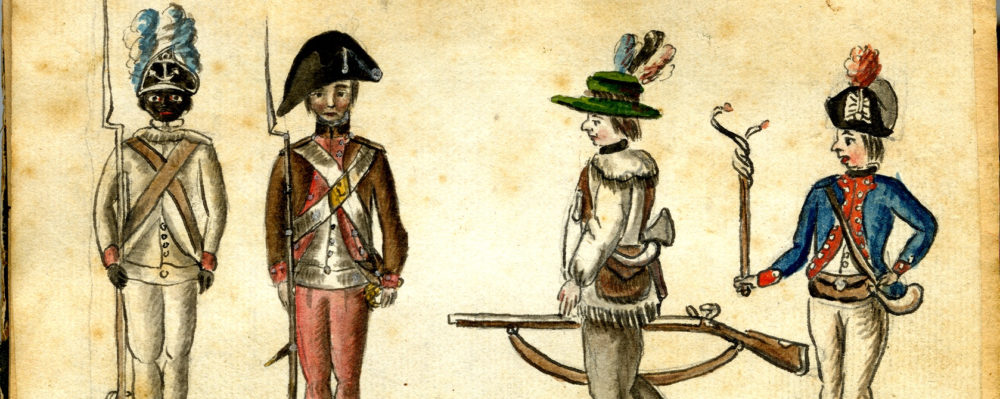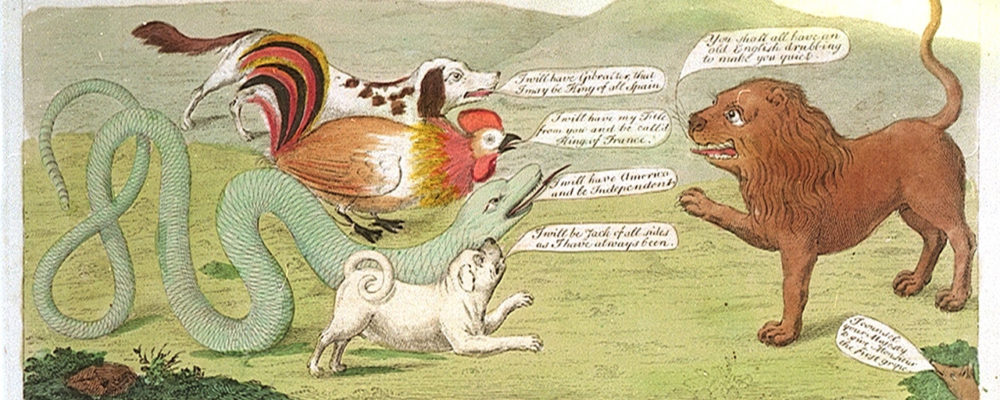
Jean-Baptiste-Antoine DeVerger, “American soldiers at the siege of Yorktown,” 1781, via Wikimedia.
Introduction
In 1763, nothing would have seemed as improbable as the American Revolution. And yet, in a little over a decade, American colonists would declare their independence and break away from the British Empire. Revolutionaries justified their new nation with radical new ideals that changed the course of history and sparked a global “age of revolution.” Men and women of all ranks contributed to the colonies’ most improbable victory, from the commoners protesting against the Stamp Act to the women who helped organize the boycotts to the Townshend duties; from the men, black and white, who fought in the army and the women who contributed to its support. Over time, the Revolution’s rhetoric of equality, as encapsulated in the Declaration of Independence, helped highlight inequalities and became a shared aspiration for future social and political movements. These sources explore the experiences of those who lived through this time of transformation and created a legacy for future generations of change-makers.
Documents
George R.T. Hewes wrote the following reminiscence of the Boston Tea Party almost 61 years after it occurred. It is likely that his memories included more than a few stories he picked up well after 1773. Nonetheless Hews provides a highly detailed account of this important event.
Britons had long understood themselves as the freest people on earth, blessed with a limited monarchy and an enlightened parliament. Paine’s pamphlet offered a very different portrayal of the British government. His criticisms swept across the North American continent and generated widespread support for American independence.
It is hard to overstate the significance of the Declaration of Independence. Designed as a measured justification for the severing of ties with Britain, the document has also functioned as a transformative piece of political philosophy. Most of the conflicts of American history from this point forward emerged from attempts to understand and implement what it means to believe “all men are created equal.”
The British faced the difficult task of fighting a war without pushing more colonists into the hands of the revolutionaries. As a result, the Revolutionary War included little direct attacks on civilians, but that does not mean that civilians did not suffer. The following account from Eliza Wilkinson describes the stress faced by non-combatants who had to face the British army.
The Oneida nation, one of the Six Nations of the Haudenosaunee (Iroquois), issued a formal declaration of neutrality on June 19, 1775 to the governor of Connecticut after the imperial crisis between Great Britain and their North American colonies erupted into violence. This declaration hints at the Oneida conceptions of their own sovereignty among the Six Nations confederacy, the independence of other Native American nations, and how the Oneida understand the conflict as a war “between two brothers.” Samuel Kirkland, a missionary living in Iroquois country, interpreted and transcribed the Oneida’s words and sent them to Governor Jonathan Trumbull of Connecticut.
Boston King was born into slavery in South Carolina in 1760. He escaped to the British Army during their invasion of South Carolina in 1780. He served as a Loyalist in the British Army, and participated in several important battles. Although captured, and once again enslaved by the Americans, King was able to escape to the British again, who secured his freedom by sending him and other Black Loyalists to Canada. Many Black colonists sought freedom by joining with the British, with estimates as high as 5,000. King later became a missionary and one of the first Black Canadian settlers of Sierra Leone in West Africa.
The American Revolution invited a reconsideration of all social inequalities. Abigail Adams, in this letter to her husband John Adams, asked her husband to “remember the ladies” in any new laws he may create. In his reply, John Adams treated this sentiment as a joke, demonstrating the limits of revolutionary liberty.
Media
Political cartoons provide insight into public opinion and the decisions made by politicians. These cartoons became an important medium for voicing criticism and dissent during the American Revolution. In this 1782 cartoon, the British lion faces a spaniel (Spain), a rooster (France), a rattlesnake (America), and a pug dog (Netherlands). Though the caption predicts Britain’s success, it illustrates that Britain faced challenges –and therefore drains on their military and treasury—from more than just the American rebels.

Jean-Baptiste-Antoine DeVerger, “American soldiers at the siege of Yorktown,” 1781, via Wikimedia.
American soldiers came from a variety of backgrounds and had numerous reasons for fighting with the American army. Jean-Baptiste-Antoine DeVerger, a French sublieutenant at the Battle of Yorktown, painted this watercolor soon after that battle and chose to depict four men in men military dress: an African American soldier from the 2nd Rhode Island Regiment, a man in the homespun of the militia, another wearing the common “hunting shirt” of the frontier, and the French soldier on the end.


